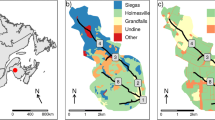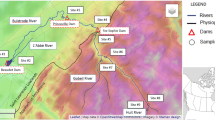Abstract
Purpose
Sediments adversely impact the quality of surface waters and are a significant source of contaminants, such as nutrients and pesticides, in agricultural watersheds. The development of effective beneficial management practices (BMPs) to minimize these impacts requires a sound understanding of the sources of sediments. The objectives of this study were: (1) to determine the sources of sediment in an agricultural watershed in the Canadian prairies using sediment source fingerprinting and; (2) to assess the results of the sediment fingerprinting study within the context of the scale of observation and the hydro-geomorphic connectivity of the watershed.
Materials and methods
Geochemical and radionuclide fingerprints were used to discriminate between the three potential sediment sources identified: topsoil, streambanks, and shale bedrock. Suspended and bed sediment samples were collected over the course of 3 years at six locations along the main stem of the creek, ranging from 3rd- (48 ha) to 7th-order (7441 ha) drainage basins. Four sediment fingerprint properties were selected that met statistical- and process-based selection criteria and the Stable Isotope Analysis in R model was used to estimate the proportion of sediment derived from each source at each sampling location in the watershed.
Results and discussion
The suspended sediments in the upper reaches were dominated by topsoil sources (64%–85%), whereas the suspended sediments moving through the lower reaches and being exported from the watershed had a higher proportion of sediment coming from streambank (32%–51%) and shale bedrock (29%–40%) sources. The switch in the sources of sediment between the headwaters and the watershed outlet are due to: (1) changes in sediment storage and connectivity; (2) a transition in the dominant erosion processes from topsoil to streambank erosion; and (3) the incision of the stream through the shale bedrock as it crosses the Manitoba Escarpment.
Conclusions
The results of this sediment fingerprinting study demonstrated that there was a switch in sediment sources between the headwaters and the outlet of the watershed. This research highlights the importance of the sampling location, in relation to the scale and geomorphic connectivity of the watershed, on the interpretation of results derived from the sediment fingerprinting technique, particularly in terms of developing suitable watershed BMPs to protect surface waters.






Similar content being viewed by others
References
Agriculture and Agri-Food Canada (2012) Watershed Evaluation of Beneficial Management Practices (WEBs) fact sheet. http://www4.agr.gc.ca/AAFC-AAC/display-afficher.do?id=1185217272386&lang=eng
Belmont P (2011) Floodplain width adjustments in response to rapid base level fall and knickpoint migration. Geomorphology 128:92–102
Belmont P, Gran KB, Schottler SP, Wilcock PR, Day SS, Jennings C, Lauer JW, Viparelli E, Willenbring JK, Engstrom DR, Parker G (2011) Large shift in source of fine sediment in the upper Mississippi River. Environ Sci Technol 45:8804–8810
Blann K, Anderson J, Sands G, Vondracek B (2009) Effects of agricultural drainage on aquatic ecosystems: a review. Crit Rev Environ Sci Techol 39:909–1001
Choi J, Park J-W (2005) Competitive adsorption of heavy metals and uranium on soil constituents and microorganism. Geosci J 9:53–61
Cornu S, Lucas Y, Lebon E, Ambrosi JP, Luizão F, Rouiller J, Bonnay M, Neal C (1999) Evidence of titanium mobility in soil profiles, Manaus, central Amazonia. Geoderma 91:281–295
Dąbkowska-Naskręket H, Jaworska H (2001) Titanium in Alfisols formed from glacial deposits of different ages in Poland. Quat Int 78:61–67
Davis CM, Fox JF (2009) Sediment fingerprinting: Review of the method and future improvements for allocating nonpoint source pollution. J Environ Eng 135:490–504
Du J, Bao J, Hu Q, Ewing RP (2012) Uranium release from different size fractions of sediments in Hanford 300 area, Washington, USA. J Environ Radioactiv 107:92–94
Environment Canada (2013a) Weather Office. http://www.weatheroffice.gc.ca
Environment Canada (2013b) Water Survey of Canada. http://www.ec.gc.ca/rhc-wsc/
Evans M, Hastings N, Peacock B (2000) Statistical distributions, 3rd edn. Wiley, New York, NY, USA
Fryirs K (2013) (Dis)connectivity in catchment sediment cascades: a fresh look at the sediment delivery problem. Earth Surf Process Landforms 38:30–46
Garrett RG, Thorleifson LH (1999) The provenance of prairie tills and its importance in mineral exploration. In: Ashton K, Harper C (eds) Advances in Saskatchewan geology and mineral exploration. Saskatchewan Geological Society, Regina, SK, Canada, pp 155–162
Gellis AC, Walling DE (2011) Sediment source fingerprinting (tracing) and sediment budgets as tools in targeting river and watershed restoration programs. In: Simon A, Bennet SJ, Castro JM (eds) Stream restoration in dynamic fluvial systems: scientific approaches, analyses, and tools. Geophysical Monograph Series, American Geophysical Union, Washington, DC, USA, 194:263–291
Haluschak P, Eilers RG, Mills GF, Grift S (1998) Status of selected trace elements in agricultural soils of southern Manitoba. Land Resource Unit, Brandon Research Centre, Research Branch, Agriculture and Agri-Food Canada, Brandon, MB, Canada
He Q, Walling D (1996) Interpreting particle size effects in the adsorption of 137Cs and unsupported 210Pb by mineral soils and sediments. J Environ Radioactiv 30:117–137
Hope J, Harker D, Townley-Smith L (2002) Ten years of monitoring in the South Tobacco Creek watershed. Agriculture and Agri-Food Canada, Regina, SK, Canada
Horowitz AJ (1991) A primer on sediment-trace element chemistry, 2nd edn. Lewis Publishers, Chelsea, MI, USA
Jackson AL, Inger R, Bearhop S, Parnell A (2009) Erroneous behaviour of MixSIR, a recently published Bayesian isotope mixing model: a discussion of Moore & Semmens (2008). Ecol Lett 12:E1–E5
Kabata-Pendias A (2000) Trace elements in soils and plants, 3rd edn. CRC Press, Boca Raton, FL, USA
Koiter AJ, Owens PN, Petticrew EL, Lobb DA (2013) The behavioural characteristics of sediment properties and their implications for sediment fingerprinting as an approach for identifying sediment sources in river basins. Earth Sci Rev 125:24–42
Kuo CW, Brierley GJ (2013) The influence of landscape configuration upon patterns of sediment storage in a highly connected river system. Geomorphology 180–181:255–266
Lake Winnipeg Stewardship Board (2006) Reducing nutrient loading to Lake Winnipeg and its watershed: our collective responsibility and commitment to action. Lake Winnipeg Stewardship Board, Gimli, Manitoba, Canada
Li S (2011) Extracting hydrologic network of the South Tobacco Creek watershed through terrain analysis on Lidar DEM: preliminary results of the second trial run. Agriculture and Agri-Food Canada, Winnipeg, MB, Canada
Li S, Elliott JA, Tiessen KHD, Yarotski J, Lobb DA, Flaten DN (2011) The effects of multiple beneficial management practices on hydrology and nutrient losses in a small watershed in the Canadian prairies. J Environ Qual 40:1627–1642
Li S, Lobb DA, Lindstrom MJ (2007a) Tillage translocation and tillage erosion in cereal-based production in Manitoba, Canada. Soil Till Res 94:164–182
Li S, Lobb DA, Lindstrom MJ, Farenhorst A (2007b) Tillage and water erosion on different landscapes in the northern North American Great Plains evaluated using 137Cs technique and soil erosion models. Catena 70:493–505
Li S, Lobb DA, Lindstrom MJ, Farenhorst A (2008) Patterns of water and tillage erosion on topographically complex landscapes in the North American Great Plains. J Soil Water Conserv 63:37–46
Liu K, Elliott JA, Lobb DA, Flaten DN, Yarotski J (2013) Critical factors affecting field-scale losses of nitrogen and phosphorus in spring snowmelt runoff in the Canadian prairies. J Environ Qual 42:484–496
Martínez-Carreras N, Krein A, Gallart F, Iffly JF, Pfister L, Hoffmann L, Owens PN (2010) Assessment of different colour parameters for discriminating potential suspended sediment sources and provenance: a multi-scale study in Luxembourg. Geomorphology 118:118–129
McNeil DH, Caldwell WGE (1981) Cretaceous rocks and their foraminifera in the Manitoba Escarpment. Geological Association of Canada, Waterloo, ON, Canada
Michaelides K, Chappell A (2009) Connectivity as a concept for characterising hydrological behaviour. Hydrol Process 23:517–522
Mukundan R, Walling DE, Gellis AC, Slattery MC, Radcliffe DE (2012) Sediment source fingerprinting: transforming from a research tool to a management tool. J Amer Water Resour Assoc 48:1241–1257
Nicolas MPB, Bamburak JD (2011) Geochemistry and mineralogy of Cretaceous shale, southwestern Manitoba (parts of NTS 62F, G, J, K, N, 63C): phase 2 results. Manitoba Innovation, Energy and Mines, Manitoba Geological Survey, Winnipeg, Manitoba, Canada
Owens PN (2008) Sediment behaviour, function and management in river basins. In: Owens PN (ed) Sustainable management of sediment resources: Sediment management at the river basin scale. Elsevier, Amsterdam, Netherlands, pp 1–29
Owens PN, Blake WH, Giles TR, Williams ND (2012) Determining the effects of wildfire on sediment sources using 137Cs and unsupported 210Pb: the role of landscape disturbances and driving forces. J Soils Sediments 12:982–994
Parnell A, Jackson A (2011) SIAR: Stable Isotope Analysis in R. http://cran.r-project.org/web/packages/siar/index.html
Parnell AC, Inger R, Bearhop S, Jackson AL (2010) Source partitioning using stable isotopes: coping with too much variation. PLoS One 5:e9672
Parsons AJ (2012) How useful are catchment sediment budgets? Prog Phys Geog 36:60–71
Parsons AJ, Foster IDL (2011) What can we learn about soil erosion from the use of 137Cs? Earth Sci Rev 108:101–113
Phillips JM, Russell MA, Walling DE (2000) Time-integrated sampling of fluvial suspended sediment: a simple methodology for small catchments. Hydrol Process 14:2589–2602
R Core Team (2013) R: A language and environment for statistical computing. In: R Foundation for Statistical Computing. http://www.R-project.org
Ritchie JC, McHenry JR (1990) Application of radioactive fallout cesium-137 for measuring soil erosion and sediment accumulation rates and patterns: a review. J Environ Qual 19:215–233
RStudio (2013) RStudio: Integrated development environment for R. http://www.rstudio.org/
Russell MA, Walling DE, Hodgkinson RA (2000) Appraisal of a simple sampling device for collecting time-integrated fluvial suspended sediment samples. In: Stone M (ed) The Role of Erosion and Sediment Transport in Nutrient and Contaminant Transport. IAHS Publ 263, IAHS Press, Wallingford, UK. pp. 119–127
Russell MA, Walling DE, Hodgkinson RA (2001) Suspended sediment sources in two small lowland agricultural catchments in the UK. J Hydrol 252:1–24
Schindler DW, Hecky RE, McCullough GK (2012) The rapid eutrophication of Lake Winnipeg: greening under global change. J Great Lakes Res 38(Supplement 3):6–13
Smith HG, Dragovich D (2008) Improving precision in sediment source and erosion process distinction in an upland catchment, south-eastern Australia. Catena 72:191–203
Statistics Canada (2012) 2011 Census of agriculture. http://www.statcan.gc.ca
Storti F, Balsamo F (2010) Particle size distributions by laser diffraction: sensitivity of granular matter strength to analytical operating procedures. Solid Earth 1:25–48
Taboada T, Cortizas AM, García C, García-Rodeja E (2006) Particle-size fractionation of titanium and zirconium during weathering and pedogenesis of granitic rocks in NW Spain. Geoderma 131:218–236
Thompson JJD, Doody DG, Flynn R, Watson CJ (2012) Dynamics of critical source areas: does connectivity explain chemistry? Sci Total Environ 435:499–508
Tiessen KHD, Elliott JA, Stainton M, Yarotski J, Flaten DN, Lobb DA (2011) The effectiveness of small-scale headwater storage dams and reservoirs on stream water quality and quantity in the Canadian Prairies. J Soil Water Conserv 66:158–171
Tiessen KHD, Elliott JA, Yarotski J, Lobb DA, Flaten DN, Glozier NE (2010) Conventional and conservation tillage: influence on seasonal runoff, sediment, and nutrient losses in the Canadian prairies. J Environ Qual 39:964–980
Wallbrink PJ, Murray AS, Olley JM, Olive LJ (1998) Determining sources and transit times of suspended sediment in the Murrumbidgee River, New South Wales, Australia, using fallout 137Cs and 210Pb. Water Resour Res 34:879–887
Walling DE (1983) The sediment delivery problem. J Hydrol 65:209–237
Walling DE, Owens PN, Leeks GJL (1999) Fingerprinting suspended sediment sources in the catchment of the River Ouse, Yorkshire, UK. Hydrol Process 13:955–975
Wickham H (2009) ggplot2: elegant graphics for data analysis. Springer, New York, NY, USA
Yarotski J (1996) South Tobacco Creek pilot project effects of headwater storage on runoff peaks. Agriculture and Agri-Food Canada, Prairie Farm Rehabilitation Administration, Regina, Saskatchewan, Canada
Acknowledgments
The first author is supported by the Natural Science and Engineering Research Council (NSERC) of Canada through the Alexander Graham Bell Canada Graduate Scholarship Program. This work is funded by a NSERC Strategic Grant—Development of environmental fingerprinting techniques for sources of sediment and associated phosphorus within agricultural watersheds of Canada—to DAL, PNO, and ELP. The comments of two anonymous referees are greatly appreciated.
Author information
Authors and Affiliations
Corresponding author
Additional information
Responsible editor: Rajith Mukundan
Rights and permissions
About this article
Cite this article
Koiter, A.J., Lobb, D.A., Owens, P.N. et al. Investigating the role of connectivity and scale in assessing the sources of sediment in an agricultural watershed in the Canadian prairies using sediment source fingerprinting. J Soils Sediments 13, 1676–1691 (2013). https://doi.org/10.1007/s11368-013-0762-7
Received:
Accepted:
Published:
Issue Date:
DOI: https://doi.org/10.1007/s11368-013-0762-7




